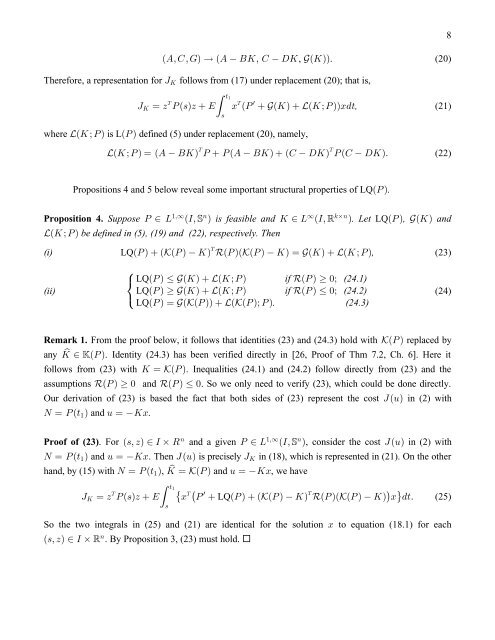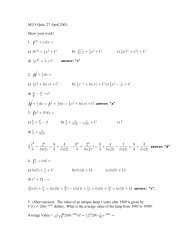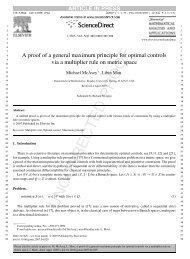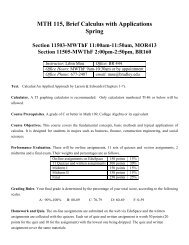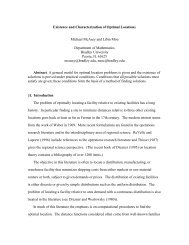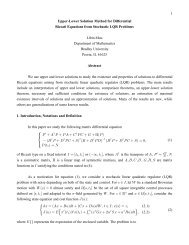1 Upper-Lower Solution Method for Differential Riccati Equations ...
1 Upper-Lower Solution Method for Differential Riccati Equations ...
1 Upper-Lower Solution Method for Differential Riccati Equations ...
Create successful ePaper yourself
Turn your PDF publications into a flip-book with our unique Google optimized e-Paper software.
8<br />
aEßGßKb Ä aE FOßG HO, ZaObb. (20)<br />
There<strong>for</strong>e, a representation <strong>for</strong> N O follows from (17) under replacement (20); that is,<br />
NO<br />
œ D X T ab =D€I( B X aT € Z aO b€ _ aOàTbbB.><br />
, (21)<br />
where _aOàT b is L aT<br />
b defined (5) under replacement (20), namely,<br />
=<br />
><br />
"<br />
w<br />
X<br />
X<br />
_aOàTbœ aE FOb T€TaE FO b€ aG HOb TaG HObÞ<br />
(22)<br />
Propositions 4 and 5 below reveal some important structural properties of LQaT b.<br />
Proposition 4. Suppose TP "ß_ a 8<br />
Mß b _ 5‚8<br />
’ is feasible and O P aMß‘<br />
b. Let LQ a T b , Z a O b and<br />
_aOàT b be defined in (5), (19) and (22), respectively. Then<br />
(i) LQ aT b€ a^aTb Ob X e aTba^aTb<br />
Ob<br />
œ Z aO b€ _ aOàTb,<br />
(23)<br />
(ii)<br />
Ú LQaTb Ÿ Z aO b€ _ aOàTb if eaT b !à (24.1)<br />
Û LQaT b Z aO b€ _ aOàTb if eaTb<br />
Ÿ!à (24.2)<br />
Ü LQaTb œ Z a^aTbb€ _ a^aT bàTb.<br />
(24.3)<br />
(24)<br />
Remark 1. From the proof below, it follows that identities (23) and (24.3) hold with ^aT b replaced by<br />
any O s ŠaTb. Identity (24.3) has been verified directly in [26, Proof of Thm 7.2, Ch. 6]. Here it<br />
follows from (23) with Oœ^aT<br />
b.<br />
Inequalities (24.1) and (24.2) follow directly from (23) and the<br />
assumptions eaT b ! and eaTb<br />
Ÿ! . So we only need to verify (23), which could be done directly.<br />
Our derivation of (23) is based the fact that both sides of (23) represent the cost N a?<br />
b in (2) with<br />
RœT a> " b and ?œ OB.<br />
Proof of (23). For a=ßDb<br />
M‚V 8 "ß_ 8<br />
and a given TP aM ß’ b, consider the cost N a?<br />
b in (2) with<br />
RœT a> " b and ?œ OB. Then N a? b is precisely NO<br />
in (18), which is represented in (21). On the other<br />
hand, by (15) with RœT a> b, Oœ s aT b and ?œ OB, we have<br />
" ^<br />
X X w<br />
X<br />
N œD T ab =D€I( ˜ B ˆ T € LQaT b€ a^aTb Ob e aTba^aTb<br />
Ob<br />
‰ B .>Þ (25)<br />
O<br />
=<br />
><br />
"<br />
So the two integrals in (25) and (21) are identical <strong>for</strong> the solution<br />
a=ßDb<br />
M‚‘ 8 . By Proposition 3, (23) must hold. ¨<br />
B<br />
to equation (18.1) <strong>for</strong> each


